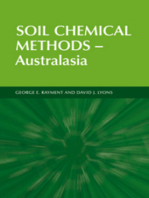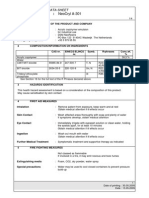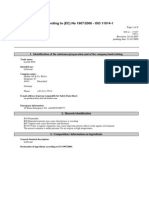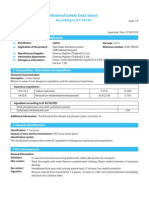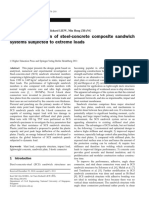Fds Chlorure Ferrique GB v1
Fds Chlorure Ferrique GB v1
Uploaded by
John JohnsonCopyright:
Available Formats
Fds Chlorure Ferrique GB v1
Fds Chlorure Ferrique GB v1
Uploaded by
John JohnsonOriginal Description:
Original Title
Copyright
Available Formats
Share this document
Did you find this document useful?
Is this content inappropriate?
Copyright:
Available Formats
Fds Chlorure Ferrique GB v1
Fds Chlorure Ferrique GB v1
Uploaded by
John JohnsonCopyright:
Available Formats
Ma t er ia l S af e t y D at a S he e t
Document name : FDS_FECL3
IRON III CHLORIDE
Reg ul at i on ( C E) N 4 5 3/ 2 01 0 and Reg ul at i on R E AC H ( C E) N 1 9 07 / 20 0 6
Mo d if ic at i o n d at e : 1 2/ 07 / 20 1 1 Cre at i o n d at e : 2 8/ 01 / 20 1 1 R v n : 1
SECTION 1 Identification of the substance/preparation and company/business :
1.1 Product identification : Product name IUPAC Nomenclature Annex VI Index N CAS N REACH Number Synonym 1.2 Product use : : : : : : : IRON CHLORIDE Iron trichloride Not indexed 7705-08-0 01-2119497998-05-0007 Ferric chloride, molyste, flores martis. Water treatment, Organic chemical catalyst, biogases production, pigments, stripper for metals, laboratory reagents, food industry, adhesives and sealants.
1.3 Corporate ID : Name Address Phone/Fax Mail address Internet address 1.4 Emergency call number : ORFILA : (33) 1 45 42 49 49 : Socit des Produits Chimiques Harbonnires : Route de Guillaucourt 80131 Harbonnires FRANCE : (33) 3 22 85 76 30 Tel (33) 3 22 85 76 31 Fax : sce.qualite@spch.fr : http://www.spch-chemicals.com
SECTION 2 Hazard identification :
2.1 Classification of the substance or mixture : According to regulation (EC) 1272/2008 : Skin Corr. 2 Acute Tox. 4 Met. Corr. 1 Eye Dam. 1 : H315 Causes irritation. : H302 Harmful if swallowed.. : H290 May be corrosive to metals. : H318 Causes serious eye damage.
According to directive 67/548/EEC
: C Corrosive R22 Harmful if swallowed R36/37/38 Irritating to eyes, respiratory system and skin R41 Risk of serious damage to eyes
According to directive 1999/45/EC
: Not concerned
2.2 Content labelling according to regulation (EC) 1272/2008 :
Hazard symbol Signal word
: : DANGER
Page I sur 8
Hazard statements
: H318 Causes serious eye irritation H290 May be corrosive to metals. H315 Causes skin irritation. H302 Harmful if swallowed.
Legal warning : Prevention Intervention
Elimination 2.3 Other hazards
: P280 Wear protective gloves/protective clothing/eye protection/face protection. : P301+P312 IF SWALLOWED: Call a POISON CENTER or doctor/physician if you feel unwell. P302+P352 IF ON SKIN: Wash with plenty of soap and water. P305+P351+P338 IF IN EYES: Rinse cautiously with water for several minutes. Remove contact lenses, if present and easy to do. Continue rinsing. P310 Immediately call a POISON CENTER or doctor/physician. : P501 Dispose of contents/container in a specialized treatment center. : NA
SECTION 3 Composition/informations on compound : Product name Molecular formula Molar weight CAS number EC number (EINECS) Classification in according with CLP Skin Corr. 2 H315 Acute Tox. 4 H302 Met. Corr. 1 H290 Eye Dam. 1 H318 Concentration
IRON CHLORIDE
FeCl3
162,204 g.mol-1
7705-08-0
231-729-4
> 99%
SECTION 4 First aid : Appropriate protective equipment to the rescuers. Stay under the shower, remove immediately contaminated clothes (do not forget to remove the shoes). 4.1 First aid : Contact with skin and eyes : If on skin : Remove immediately clothes and shoes. Wash up immediately and plenty with water. Maintain victim in a quiet and heat place. Wash contaminated clothes before use. If eyes contact : Wash immediately and plenty with water during 15 mn holding the eyelids open. In all case, consult a specialist. Ingestion : Do not induce vomiting. Do not give drink If subject is unconscious, rinse mouth and lips, then hospitalised. : Remove patient to fresh air and keep warm. Victim should lie at rest. If breathing is stopped or irregular, practice artificial respiration and call a doctor. Do not ingest anything.
Inhalation
4.2 Main symptoms and effects, acute and delayed
: If swallowed :Abdominal pain, vomiting, diarrhea, gastritis hemorrhagic, necrosis of the stomach and duodenum, collapse, metabolic acidosis, acute renal disease, bleeding disorders, elevated liver, coma, convulsions, gastrointestinal sequelae.
Page 2 sur 8
If inhaled : Irritation of the respiratory mucosa, eye irritation. If skin contact : Skin irritations, dermatitis persistent brown pigmentation may persist for several days leading to peeling of the affected area. 4.3 Indication of any immediate medical attention and special treatment necessary : Rinse plenty with water the area affected by the substance. Consult a doctor. SECTION 5 Fire-fighting measures : 5.1 Extinguishing media : Recommended : Cool containers exposed to fire by water spraying. Prohibit ignition point at the opening of tanks. Use extinguishing measures appropriate to local conditions and the surrounding environment. : No data available.
Prohibited
5.2 Special hazards arising from the substance or mixture : Hazardous combustion products : Not flammable. In contact of certain metals and when heated, there is a formation of flammable gases (hydrogen).
5.3 Advice to fire-fighter : Protective measures Special protective equipment : In contact of certain metals and water, there is a formation of flammable gases (hydrogen). : Wear autonomous respirators and waterproof protective clothes.
SECTION 6 - Action required if accidental release : 6.1 Personal precautions, protective equipment and emergency procedures : To the non-rescuers Protection equipment Flame, ventilation, dust Emergency procedures To the rescuers Appropriate clothing
: Wear gloves (norm EN374-3), protection goggles, wear safety suitable clothing (against acids) : No data available : No data available
Inappropriate clothing 6.2 Environmental safety protection
: Respiratory protection in case of aerosol : suitable protective mask with appropriate cartridge type P2 or P3 (EN143) Hands protection : Waterproof protective gloves with chemical resistance (EN374-3). Water station near. Eyes protection : protective goggles wearing in all case of industrial operation. If risk of splashing : waterproof chemical goggle/facial shield. Skin protection : waterproof covering clothing. Track suit/slip-resistant boots in PVC, neoprene if splashing risk. Showers nearby. : No data available : Isolate the area. Should not be released to the environment. Treat contaminated soils. If the product contaminates waterways rivers or sewers, alert the relevant authorities in accordance with the statutory procedures.
Page 3 sur 8
6.3 Methods and material for containment and cleanup : Spill : Isolate the area. If possible, without expose the personnel, try to stop the leak. In case of accidental dispersion, treat contaminated soils. : Stem. recover as much liquid dispersed using compatible hardware (see section 7 and 10). Dilute the residue with water and neutralize with lime or limestone powder. Decant the ferric hydroxide. Treat contaminated soils. For elimination, refer to section 13. After cleaning, rinse the traces with water. : No data available
Cleaning procedures
Other informations SECTION 7 Handling and storage : 7.1 Precautions for safe handling : Handling Hygiene 7.2 Storage conditions
: Handling avoiding splashing. : Clean oneself after any handling. : Keep containers closed and away from reactive products. Store at temperatures above -10 C. Provide a diked area. Recommended packing materials: PVC, steel ebonite Avoid unprotected metals : For any particular use, consult the supplier.
7.3 Particular(s) final(s) use(s)
SECTION 8 Exposure control personnal safety : 8.1 Control parameters : NELVP (Directive 98/24/EC) NELVP (Directive 2004/37/EC) BLV (Directive 98/24/EC) Other limits 8.2 Exposure control : Engineering controls Individual protective measures Eyes/face protection Skin protection : Provide ventilation/or sufficient suction in the workshops. Install devices for not exceed the exposure limits. : Security showers. Eyewash. : Wear protective goggles in all case of industrial operation. : Hands protection : Waterproof protective gloves with chemical resistance (EN374-3). Skin protection : Waterproof covering clothing. Track suit/slip-resistant boots in PVC, neoprene if splashing risk. Showers nearby. : Suitable protective mask type P2 or P3 (EN143) : Exothermic reaction with strong acids. : : : : No data available No data available No data available No data available
Respiratory protection Thermal hazards
SECTION 9 Physical and chemical characteristics : 9.1 Information on physical and chemical characteristics : Aspect Smell Odor threshold pH : : : : Dark brown liquid Lightly chlored NA <1
Page 4 sur 8
Melting/freezing point Initial point and boiling range Flashpoint Evaporation rate Flammability Flammability/explosion limits Vapor pressure Vapor density Relative density Solubility Octanol/water partition coefficient Auto-flammability temperature Decomposition temperature Viscosity Explosive properties Oxidising properties 9.2 Other informations SECTION 10 Stability and reactivity : 10.1 Reactivity
: : : : : : : : : : : : : : : :
-12C 106C NA NA Non flammable NA NA No data available 1.42 g.cm-3 at 20C for an solution at 40% w/w 1.48 g.cm-3 at 20C for an solution at 45% w/w Into water : total but with an ferric hydroxide flocculation Into the solvents : very slightly soluble with the methanol and ether. NA NA 70C (with HCl formation) NA NA NA
: No data available
10.2 Chemical stability 10.3 Possibility of hazardous reactions
10.4 Conditions to avoid 10.5 Incompatible materials
10.6 Hazardous decomposition products
: Potentially exothermic. May be corrosive to metals. Metals : liberates hydrogen by reaction with metals (flammable gases). : Stable at normal use conditions : Liberates hydrogen by reaction with metals (flammable gases). Exothermic reaction with strong acids. Absorbs atmospheric carbon dioxide. : Negative temperatures. Do not expose too long with free air. : Metals : Lead, aluminium, copper, tin, zinc, bronze Products : oxidizing agents, halogens, material organic, flammables materials. : Hydrogen : flammable gases.
SECTION 11 Toxicological information :
11.1 Information on toxicological effects : Acute Skin corrosion/skin irritation Serious eyes damage/eyes irritation Respiratory or skin sensitization : LD50 (oral, rat) 450 mg.kg-1 LD50 (oral, mousse) 895 mg.kg-1 : Dermal way, LD50 (mousse) > 2000 mg.kg-1 Skin corrosive : Eyes corrosive Serious injuries with possible sequelae if not washing quickly : In contact with skin : In humans: epi-negative skin tests reported few cases of skin sensitization reported. In animals (rat): not sensitizing. : Following a studies, it is not mutagen : Following a studies, it is not carcinogen. : Following a studies, it is not toxic for a reproduction. : No data available : No data available : No data available
Germ cell mutagenicity Carcinogenicity Reproductive toxicity Specific tocixity to target organs Single exposure Repeated exposure Aspiration hazards
Page 5 sur 8
SECTION 12 Ecological information : 12.1 Toxicity : Fish Crustaceans Algae Other 12.2 Persistence and degradability 12.3 Bioaccumulation potential Octanol/water partition coefficient BCF 12.4 Mobility in soil : Adsorption Leaching Distribution between compartments Surface tension 12.5 PBT and vPvB assessment report : PBT assessment report vPvB assessment report : Following a studies : it is not PBT : Following a studies : it is not vPvB : : : : NA NA NA NA : : : : (Lepomis macrochirus) LC50/96h = 20 mg.l-1 (Daphnia magna) EC50/48h = 9,6 mg.l-1 (Anabaena doliolum) EC50/72h = 920 mg.l-1 No others data
: No data available. : NA : NA : NA
12.6 Other adverse effects : Photochemical ozone formation potential Photochemical ozone layer depletion potential Disrupting endocrine potential Global warming potential SECTION 13 Disposal consideration : 13.1 Waste treatment method : Suitable containers Waste substance treatment Substance treatment : PVC, steel ebonite : No data available : Dilute the residue with water and neutralize with lime or limestone powder. Decant the ferric hydroxide. Treat contaminated soils. For elimination, refer to section 13. After cleaning, rinse the traces with water. : Clean container with water. Recover wastewater for further treatment. Treat contaminated packaging in compliance with local and national regulations. : Liberates hydrogen by reaction with metals (flammable gases). Exothermic reaction with strong acids. Absorbs atmospheric carbon dioxide. : Treat in compliance with local and national regulation. : : : : No data available No data available No data available No data available
Packaging treatment
Physical/chemical influential property
Elimination and environment
Page 6 sur 8
SECTION 14 Transport information : 14.1 Identification : UN number Shipping name of united nations 14.2 Hazard classification for transportation : 14.2.1 Road and waterways (RID/ADR) : Class Hazard identification number Material identification number Classification code Packaging group Labelling Legal RID/ADR 14.2.2 Seeways (code IMDG) : UN number Class Labeling Hazard identification number Packaging group Hazard sheet number Legal IMDG Marine pollutant : : : : : : : : 2582 8 Corrosive -880 III F-A S-B Iron III chloride in solution NO : : : : : : : 8 80 2582 C1 III Corrosive -8Iron III chloride in solution : 2582 : Iron III chloride in solution
14.2.3 Air (IATA) : UN number Class Labelling Packaging group PSN Packaging instructions : : : : : : 2582 8 Corrosive -8III Iron III chloride in solution Cargo aircraft : 820 Aircraft : 818
quantity = 60 litres quantity = 5 litres
SECTION 15 Statutory information : A c he mi c al sa f et y r ep o r t wa s p r ep ared as p art o f th e re g i str at io n o f t h e s ub st a nce acco r d i n g to th e RE AC H R e g ula tio n ( EC) No . 1 9 0 7 /2 0 0 6 Acco rd i n g to Re g ul at io n ( EU) No . 4 5 3 /2 0 1 0 RE AC H R e g ula tio n ( E C ) No . 1 9 0 7 /2 0 0 6
SECTION 16 Others information : Bibliographical references : CSR Category Iron Salts INRS toxicological sheet No. 154
Page 7 sur 8
Section of the MSDS update All the MSDS
Classification and labelling
Type Creation in according to regulation N 453/2010 Changes according to the CSR Consortium
Date 15/11/2010
12/07/2011
Definitions : PBT vPvB Other :
: Persistent, Bioaccumulative and Toxic. : Very Persistent, Very Bioaccumulative.
Since we do not know the user's working conditions, the information supplied on this safety data sheet are based upon our current level of knowledge and upon national and Community regulations. The product must not be used for any purposes other than those listed under heading 1 without having first obtained written handling instructions. It is at all times the responsibility of the user to take all necessary measures to comply with legal requirements and local regulations. The information given on this safety data sheet must be regarded as a description of the safety requirements relating to our product and not a guarantee of its characteristics.
Page 8 sur 8
You might also like
- BuffersolDocument10 pagesBuffersolArdyas Wisnu BaskoroNo ratings yet
- Hydro X Boiler TreatmentDocument5 pagesHydro X Boiler TreatmentZoran ObradovicNo ratings yet
- Sodium Hydroxide, Pellets, Reagent ACS MSDS: Section 1: Chemical Product and Company IdentificationDocument6 pagesSodium Hydroxide, Pellets, Reagent ACS MSDS: Section 1: Chemical Product and Company IdentificationĐỗ Hữu Đạt0% (1)
- Msds 0430 Ceramco3 Modeling Liquid e 12-12-13 PDFDocument9 pagesMsds 0430 Ceramco3 Modeling Liquid e 12-12-13 PDFHugo MoralesNo ratings yet
- HCL - VL Ver.03Document5 pagesHCL - VL Ver.03qwewee123No ratings yet
- Safety Data Sheet According To (EC) No 1907/2006: TURCO 4181Document8 pagesSafety Data Sheet According To (EC) No 1907/2006: TURCO 4181Panneer SelvamNo ratings yet
- Corr Shield NT 4292Document9 pagesCorr Shield NT 4292Donatas BertasiusNo ratings yet
- 510 MSDSDocument7 pages510 MSDSAhmed Emad AhmedNo ratings yet
- Acetic AnhydrideDocument5 pagesAcetic AnhydrideChern YuanNo ratings yet
- NeoCryl A-301 MsdsDocument4 pagesNeoCryl A-301 MsdsLeandro EsvizaNo ratings yet
- OX1272Document9 pagesOX1272Donatas BertasiusNo ratings yet
- MSDS Addmix 700Document6 pagesMSDS Addmix 700Sam WitwickyNo ratings yet
- Fisa Tehnica Alcool Etilic 2019-EnglezaDocument7 pagesFisa Tehnica Alcool Etilic 2019-EnglezaMADALINA LAZARNo ratings yet
- 515 MSDSDocument5 pages515 MSDSAhmed Emad AhmedNo ratings yet
- MSDS Nitric AcidDocument7 pagesMSDS Nitric AcidDiah DarmawanNo ratings yet
- MsdsDocument5 pagesMsdsRizqi S RohmandaniNo ratings yet
- Sinobio MSDS Snpbta40Document5 pagesSinobio MSDS Snpbta40unaliu622No ratings yet
- Safety Data Sheet: Section 1: Identification of The Substance/mixture and of The Company/undertakingDocument8 pagesSafety Data Sheet: Section 1: Identification of The Substance/mixture and of The Company/undertakingsajupodiyanNo ratings yet
- EthylacetateDocument5 pagesEthylacetateA.Magied MahmoudNo ratings yet
- Gardolene D 6800 Msds Ver1Document5 pagesGardolene D 6800 Msds Ver1stuart3962No ratings yet
- Generic Msds Ammonium Persulphate1Document7 pagesGeneric Msds Ammonium Persulphate1Maria RenataNo ratings yet
- Tert-Butyl Ethyl Ether - MSDSDocument7 pagesTert-Butyl Ethyl Ether - MSDSJonny DenNo ratings yet
- Idrocrete MSDSDocument8 pagesIdrocrete MSDSMohd Khairul Md DinNo ratings yet
- 3450 Resin MsdsDocument6 pages3450 Resin MsdsAhmed Emad AhmedNo ratings yet
- 8018 MsdsDocument6 pages8018 MsdsAhmed Emad AhmedNo ratings yet
- Ident-No: ARADUR HY 951: Safety Data SheetDocument7 pagesIdent-No: ARADUR HY 951: Safety Data SheetPaulNo ratings yet
- Calcium HydroxideDocument5 pagesCalcium HydroxidemsdfvidNo ratings yet
- MSDS MC Flurry PinkDocument5 pagesMSDS MC Flurry PinkHendra SeptaNo ratings yet
- SDS Potassium Iodide 4300 EXP 2026.03Document5 pagesSDS Potassium Iodide 4300 EXP 2026.03shafaasalsabilaaaaNo ratings yet
- Hydrochloric Acid: Material Safety Data SheetDocument7 pagesHydrochloric Acid: Material Safety Data Sheetpanji ajaNo ratings yet
- 242 MSDSDocument6 pages242 MSDSAhmed Emad Ahmed100% (1)
- Na HSO3Document8 pagesNa HSO3Bao Duy NguyenNo ratings yet
- MSDS Aice Violet-Blue P2736CHS (UV-CP-8120003)Document4 pagesMSDS Aice Violet-Blue P2736CHS (UV-CP-8120003)Hendra SeptaNo ratings yet
- Safety Data Sheet: Tokyo Chemical Industry Co., LTDDocument5 pagesSafety Data Sheet: Tokyo Chemical Industry Co., LTDJonny DenNo ratings yet
- 3E Product Material Safety DataDocument6 pages3E Product Material Safety DataAhmed Emad AhmedNo ratings yet
- Cipton MSDS EngDocument4 pagesCipton MSDS EngRyan NguyenNo ratings yet
- 319 MSDSDocument6 pages319 MSDSAhmed Emad AhmedNo ratings yet
- Safety Data Sheet According To (EC) No 1907/2006 - ISO 11014-1Document5 pagesSafety Data Sheet According To (EC) No 1907/2006 - ISO 11014-1Ahmed Emad AhmedNo ratings yet
- Gardobond 24d Imu Sds Ver1Document6 pagesGardobond 24d Imu Sds Ver1stuart3962No ratings yet
- 638 MSDSDocument6 pages638 MSDSAhmed Emad AhmedNo ratings yet
- SRB-Universal Transmission Oil MSDSDocument7 pagesSRB-Universal Transmission Oil MSDSBen WigginsNo ratings yet
- 603 MSDSDocument5 pages603 MSDSAhmed Emad AhmedNo ratings yet
- Cruising Performer Safety Data SheetDocument10 pagesCruising Performer Safety Data Sheetapi-266933400No ratings yet
- Trichloroacetic AcidDocument10 pagesTrichloroacetic Acidwillyvh99No ratings yet
- 660 MSDSDocument5 pages660 MSDSAhmed Emad AhmedNo ratings yet
- Sodium Hydroxide, Pellets, Reagent ACS MSDS: Section 1: Chemical Product and Company IdentificationDocument6 pagesSodium Hydroxide, Pellets, Reagent ACS MSDS: Section 1: Chemical Product and Company IdentificationyoukahoNo ratings yet
- Msds NaOH Natrium HidroksidaDocument6 pagesMsds NaOH Natrium HidroksidasilviaNo ratings yet
- Front Side Silver Paste 653G SDS - GENERAL - TEXANOL (English Version) V2.7 (PB)Document6 pagesFront Side Silver Paste 653G SDS - GENERAL - TEXANOL (English Version) V2.7 (PB)Desheng ChewNo ratings yet
- Foodlube Multipaste Spray MsdsDocument7 pagesFoodlube Multipaste Spray MsdsfahreezNo ratings yet
- Safety Data SheetDocument9 pagesSafety Data SheetTri NastitiNo ratings yet
- AntifreezeDocument12 pagesAntifreezeArdyas Wisnu BaskoroNo ratings yet
- NaOH 45Document7 pagesNaOH 45Bao Duy NguyenNo ratings yet
- Safety Data Sheet: 1. Identification of The Substance/preparation and of The Company/undertakingDocument5 pagesSafety Data Sheet: 1. Identification of The Substance/preparation and of The Company/undertakingAsanka AnuradhaNo ratings yet
- Occupational and Environmental Lung Diseases: Diseases from Work, Home, Outdoor and Other ExposuresFrom EverandOccupational and Environmental Lung Diseases: Diseases from Work, Home, Outdoor and Other ExposuresSusan TarloNo ratings yet
- REACH Compliance: The Great Challenge for Globally Acting EnterprisesFrom EverandREACH Compliance: The Great Challenge for Globally Acting EnterprisesNo ratings yet
- Self-Cleaning Materials and Surfaces: A Nanotechnology ApproachFrom EverandSelf-Cleaning Materials and Surfaces: A Nanotechnology ApproachWalid A. DaoudRating: 5 out of 5 stars5/5 (1)
- Green Chemistry for Dyes Removal from Waste Water: Research Trends and ApplicationsFrom EverandGreen Chemistry for Dyes Removal from Waste Water: Research Trends and ApplicationsNo ratings yet
- Food Processing HandbookFrom EverandFood Processing HandbookJames G. BrennanRating: 4 out of 5 stars4/5 (2)
- Filler Metal ClassificationsDocument16 pagesFiller Metal ClassificationsAamer MohammedNo ratings yet
- Minimum Requirements IweDocument52 pagesMinimum Requirements IweIonutz TelteuNo ratings yet
- Quantitative Research - Group3 1Document14 pagesQuantitative Research - Group3 1api-709918261No ratings yet
- Sika-Wrap Struct StrengthDocument7 pagesSika-Wrap Struct StrengthMiky CastenNo ratings yet
- 9 - Analysis and Design of Steel-Concrete Composite SandwichDocument17 pages9 - Analysis and Design of Steel-Concrete Composite SandwichAri Endra NasutionNo ratings yet
- DF (Linear Driving Force) and FD (Fickian Diffusion)Document32 pagesDF (Linear Driving Force) and FD (Fickian Diffusion)hakita86No ratings yet
- Solenoid VALVES ASCODocument4 pagesSolenoid VALVES ASCOGeorgios MariolisNo ratings yet
- Hsslive XI Environmental Chemistry NotesDocument3 pagesHsslive XI Environmental Chemistry NotesAnonymous 9uu04elNo ratings yet
- Depth Dependent Measurements With The QCSM ModuleDocument5 pagesDepth Dependent Measurements With The QCSM ModuleVijaiNo ratings yet
- Satam Zc17-B037-Bro-Gb-Rev3Document2 pagesSatam Zc17-B037-Bro-Gb-Rev3warung1bensinNo ratings yet
- Prasanna - PP E-WasteDocument12 pagesPrasanna - PP E-Wastesriprasannaa pNo ratings yet
- 12 Different Types of Pillows For Every Sleeping Position - Casper BlogDocument17 pages12 Different Types of Pillows For Every Sleeping Position - Casper BlogMUHAMMAD AZHAR GHAFOORNo ratings yet
- Industrial Acids and BasesDocument105 pagesIndustrial Acids and BasesJohn Patrick DagleNo ratings yet
- SOLIDS AND THEIR Properties 1Document4 pagesSOLIDS AND THEIR Properties 1JohnnardBelenNo ratings yet
- Physics 23 Jul by Razz..Document3 pagesPhysics 23 Jul by Razz..Ajay KunduNo ratings yet
- Tadao Ando Concrete PDFDocument8 pagesTadao Ando Concrete PDFAlonso StrokesNo ratings yet
- Use of Rubber Particles From Recycled TiDocument11 pagesUse of Rubber Particles From Recycled TiNandkumar GowdaNo ratings yet
- Hinotek FP640 Flamephotometer ManualDocument17 pagesHinotek FP640 Flamephotometer ManualKader SmailiNo ratings yet
- Long-Life Chain & Cable GreaseDocument2 pagesLong-Life Chain & Cable Greasechem KhanNo ratings yet
- Sample Paper 2 12thDocument13 pagesSample Paper 2 12thShreya DubeyNo ratings yet
- Graham Bizley (2008) Architecture in Detail 1Document2 pagesGraham Bizley (2008) Architecture in Detail 1MiguelMejiaTamariz0% (1)
- TDS - Mastertop 1332Document2 pagesTDS - Mastertop 1332Venkata RaoNo ratings yet
- Description of The Construction Product: 1.2.1 Intended Use(s)Document18 pagesDescription of The Construction Product: 1.2.1 Intended Use(s)Ivelina AngelovaNo ratings yet
- The Role of Ore Properties in Thickening ProcessDocument12 pagesThe Role of Ore Properties in Thickening ProcessJeromeNo ratings yet
- Gas Laws: Ideal and Real GaesDocument38 pagesGas Laws: Ideal and Real GaesAnonymous Hntzyz7No ratings yet
- Cyanide, Method 8027, 02-2009, 9th EdDocument10 pagesCyanide, Method 8027, 02-2009, 9th EdPurnamazNo ratings yet
- Jurnal Rekayasa Material, Manufaktur Dan EnergiDocument8 pagesJurnal Rekayasa Material, Manufaktur Dan EnergiVinkaNo ratings yet
- Borchers - How To Formulate MEKOfree Alkyds and Achieve High PerformanceDocument33 pagesBorchers - How To Formulate MEKOfree Alkyds and Achieve High PerformanceBasem MahmoudNo ratings yet
- Engineering Materials SyllabusDocument3 pagesEngineering Materials Syllabusmudassirbasha04No ratings yet
- Iron StoneDocument12 pagesIron StoneRino Dwi HutamaNo ratings yet
